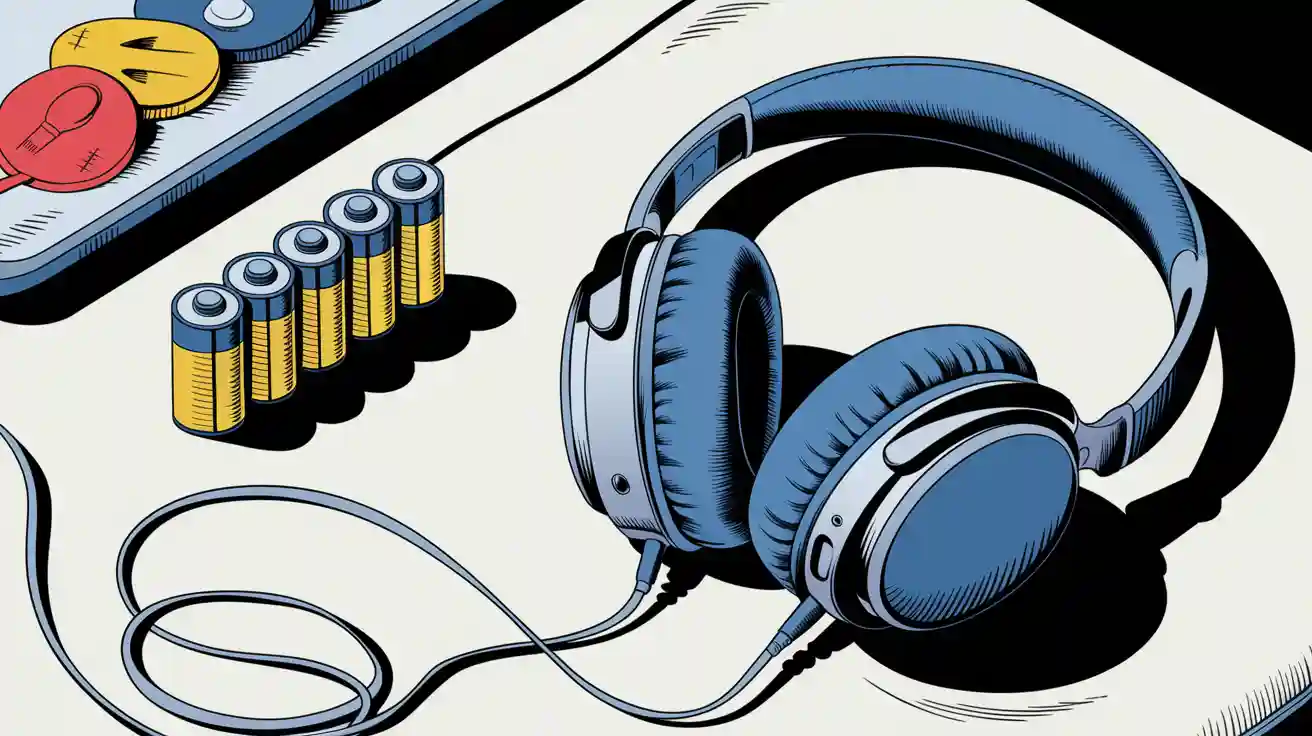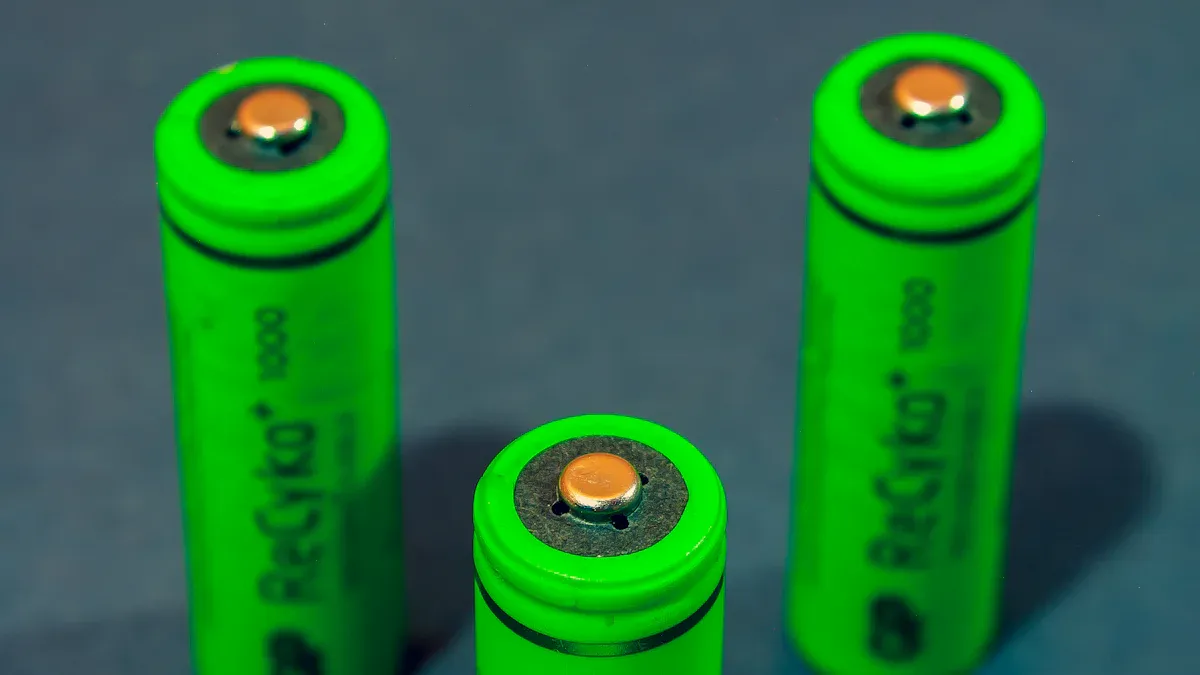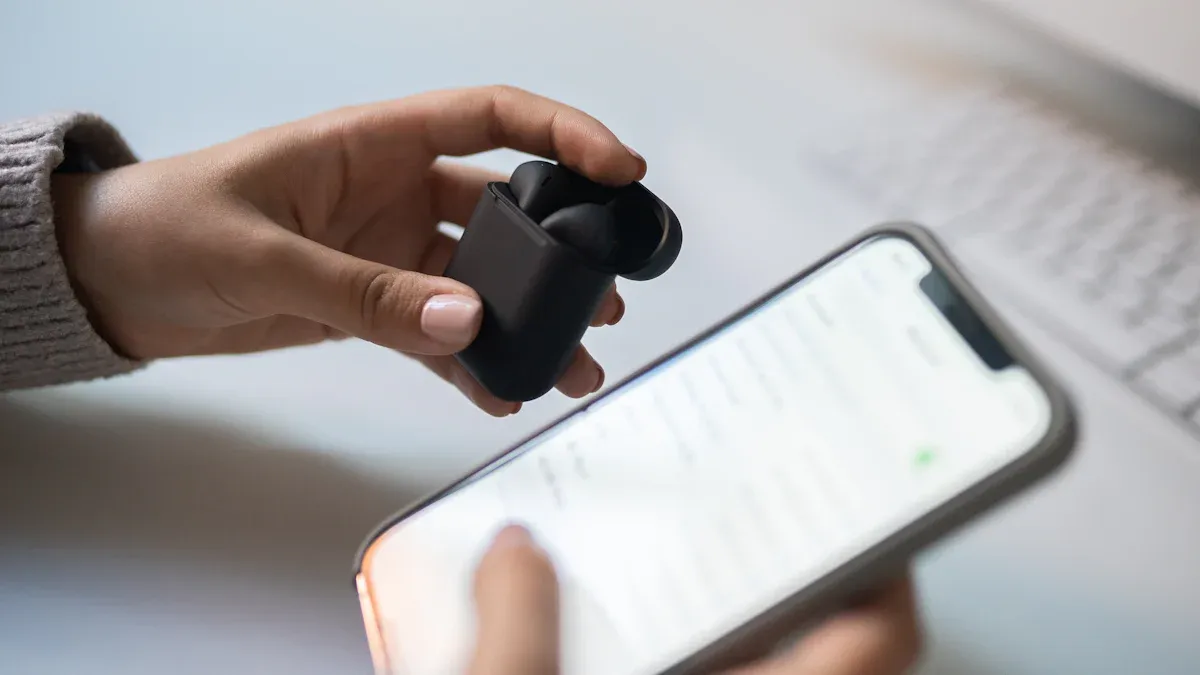
Bluetooth headphones rely on advanced rechargeable lithium-ion batteries and lithium-polymer batteries to deliver exceptional performance, as highlighted in our bluetooth headphone battery guide. These batteries ensure efficient energy storage, compactness, and durability. Consumer trends reveal that 68% of users prefer devices with over 20 hours of playtime, while 53% value rapid charging. Additionally, certifications like UL 2054 enhance safety, reducing battery-related incidents by 38%. This makes them ideal for modern audio demands.
Key Takeaways
Bluetooth headphones mostly use lithium-ion and lithium-polymer batteries. These batteries are small and work well for long use.
Take care of the battery by not overcharging it. Keep it away from very hot or cold places to make it last longer.
New battery types, like solid-state ones, may be safer. Look for eco-friendly choices to help protect the environment.
Part 1: Types of Batteries in Bluetooth Headphones

1.1 Lithium-Ion Batteries: The Standard Choice
Lithium-ion batteries are the most common type of rechargeable batteries in headphones. Their high energy density and reliability make them the preferred choice for manufacturers. These batteries can store significant amounts of energy in a compact form, enabling Bluetooth headphones to deliver extended playback times. For instance, over-ear models powered by lithium-ion batteries can provide up to 40 hours of continuous use.
You’ll also appreciate their longevity. Lithium-ion batteries can endure hundreds of charge cycles before noticeable degradation occurs. This durability ensures that your headphones maintain consistent performance over time. However, these batteries require careful handling to avoid overheating, which can compromise safety.
Tip: If you’re looking for headphones with long-lasting performance, prioritize models featuring lithium-ion batteries. Their proven track record in consumer electronics ensures reliability.
For more details on lithium-ion technology, visit this resource.
1.2 Lithium-Polymer Batteries: Lightweight and Flexible
Lithium-polymer (LiPo) batteries offer a modern alternative to traditional lithium-ion batteries. These batteries are known for their lightweight design and flexibility, making them ideal for smaller devices like in-ear Bluetooth headphones. With an energy density of 300-400 Wh/kg, lithium-polymer batteries enable manufacturers to create thinner and more portable headphone designs without sacrificing performance.
Another advantage is their fast-charging capability. Lithium-polymer batteries support charging speeds of 2-3C, allowing you to quickly recharge your headphones and get back to enjoying your music. Their ability to be molded into various shapes also enhances the ergonomic design of headphones, ensuring a comfortable fit for users.
Note: While lithium-polymer batteries excel in portability, they may not match the longevity of lithium-ion batteries in terms of charge cycles. Consider your usage habits when choosing between these two options.
Learn more about lithium-polymer batteries from Large Power.
1.3 Other Battery Types: NiMH and Emerging Alternatives
Although lithium batteries dominate the market, other types like Nickel Metal Hydride (NiMH) and Nickel Cadmium (NiCd) have also been used in Bluetooth headphones. NiMH batteries, for example, offer a balance between cost and performance. They can provide up to 40 hours of battery life in wireless headphones, making them a viable option for mid-range models.
However, NiCd batteries have largely fallen out of favor due to their poor energy density and environmental concerns. Emerging technologies, such as solid-state batteries, are gaining attention for their potential to enhance safety and design flexibility. These innovations could revolutionize the future of batteries in headphones, offering even greater energy efficiency and durability.
Did You Know? Solid-state batteries boast an energy density of 300-500 Wh/kg, making them a promising candidate for next-generation Bluetooth headphones.
For sustainable battery solutions, explore this link.
Part 2: Bluetooth Headphone Battery Guide to Performance
2.1 Energy Density and Playback Time
Energy density plays a crucial role in determining the playback time of Bluetooth headphones. Higher energy density allows batteries to store more power in a compact form, enabling longer listening sessions without increasing the device’s weight. Advancements in polymer-based cells have significantly improved energy density, making modern headphones lighter and more efficient.
Quick-charge protocols further enhance usability. These technologies allow you to regain hours of playback time within minutes, catering to the growing demand for convenience. For example, lithium-ion and lithium-polymer batteries often support charging times of two hours or less, ensuring minimal downtime.
Aspect | Details |
|---|---|
Battery Technology | Advancements in polymer-based cells have improved energy density while reducing weight. |
Playback Duration | Enhanced energy density enables longer playback times without compromising design. |
Charging Methodologies | Quick-charge protocols allow users to regain hours of listening time in minutes. |
Consumer Demands | Increased expectations for longer runtimes and faster charging due to evolving user behavior. |
Bluetooth headphone batteries typically offer continuous playback of over 10 hours, meeting the expectations of most users. If you prioritize longer battery life, opt for models featuring lithium-ion or lithium-polymer batteries.
2.2 Lifespan and Recharge Cycles
The lifespan of a Bluetooth headphone battery depends on its recharge cycles and internal resistance. Lithium-ion batteries, for instance, retain up to 80% of their original capacity after 500 cycles. This durability ensures consistent performance for years, with an expected lifespan of 4-8 years before significant degradation occurs.
Metric | Value |
|---|---|
Capacity after 500 cycles | Drops to 80% of original |
Internal resistance increase | About 20% |
Charging time extension | 15-25% longer |
Expected lifespan | 4-8 years before significant degradation |
To maximize battery life, avoid overcharging and exposure to extreme temperatures. Proper care can extend the lifespan of your headphones, reducing the need for frequent replacements.
2.3 Environmental and Usage Factors
Environmental conditions and usage patterns significantly impact battery performance. Components like Bluetooth antennas generate heat, which can damage the battery over time. Temperature fluctuations and air quality also affect battery life, emphasizing the importance of proper packaging and design.
The Bluetooth antenna and circuits create a temperature gradient that damages the battery.
Environmental factors such as temperature changes and air quality affect battery life.
Better packaging mitigates damage from other components.
Factor | Impact on Battery Performance |
|---|---|
Manufacturing Phase | Contributes 81.2% to total climate impact |
Repair Scenario | Reduces global warming potential per hour |
Usage Hours | Assumed lifetime of 2,600 hours for assessment |
Climate Impact | Total of 12.17 kg CO2-Eq for the lifecycle |
For sustainable solutions, consider headphones with eco-friendly batteries. Large Power offers custom battery solutions that align with environmental goals.
Part 3: Future Trends in Bluetooth Headphone Battery Technology

3.1 Solid-State Batteries for Enhanced Safety
Solid-state batteries represent a promising advancement in Bluetooth headphone technology. These batteries replace liquid electrolytes with solid materials, reducing risks like thermal runaway and overheating. You’ll benefit from improved safety features, including ceramic-coated separators that enhance thermal management. Devices certified under standards like UL 2054 and IEC 60086-4 have already seen a 38% reduction in battery-related incidents between 2021 and 2023.
Solid-state batteries also offer higher energy density, ranging from 300 to 500 Wh/kg, enabling longer playback times without increasing headphone size. Their durability and compact design make them ideal for true wireless earbuds, which require frequent charging due to their small form factor.
Tip: If safety and extended battery life are priorities, consider headphones equipped with solid-state batteries. Learn more about this technology here.
3.2 Fast-Charging and Wireless Charging Innovations
Fast-charging technology is transforming how you use Bluetooth headphones. Modern batteries now support charging speeds of 2-3C, allowing you to regain hours of playback in minutes. Wireless charging pads further enhance convenience by eliminating the need for cables.
Manufacturers are integrating AI-driven charging systems that optimize power delivery based on usage patterns. This innovation ensures efficient energy management, extending battery lifespan. With the Bluetooth headphone market projected to grow at a CAGR of 35% from 2024 to 2033, fast-charging and wireless solutions will likely become standard features.
3.3 Eco-Friendly and Sustainable Battery Solutions
Sustainability is shaping the future of headphone batteries. You’ll notice a shift toward eco-friendly materials and manufacturing processes that minimize environmental impact. For example, some brands are adopting conflict-free minerals and recyclable components to align with global sustainability goals.
Did You Know? The lifecycle of a typical Bluetooth headphone battery contributes 12.17 kg CO2-Eq to climate impact. Choosing sustainable options can significantly reduce this footprint.
Large Power offers custom battery solutions tailored to meet your environmental and performance needs.
Bluetooth headphones rely on lithium-ion and lithium-polymer batteries for their efficiency and compact design. These batteries dominate the market due to their ability to deliver exceptional battery life while maintaining portability. For instance, models like the Sennheiser Momentum 5 offer up to 60 hours of playback, showcasing the impressive performance of modern battery technology.
Proper care can significantly enhance battery life. Avoid overcharging and extreme temperatures to maintain optimal performance. Many headphones now support fast charging, allowing you to regain hours of playback in minutes. For example, the Bose Ultra Quiet Pro provides 4 hours of playback with just a 10-minute charge.
Future advancements promise even greater benefits. Solid-state batteries will enhance safety, while eco-friendly materials will reduce environmental impact. As technology evolves, you can expect longer battery life, faster charging, and more sustainable solutions.
Brand & Model | Battery Life (Hours) | Fast Charge Support | Battery Capacity (mAh) | Price Range |
|---|---|---|---|---|
Sony WH-2025X | 50h (ANC On) | 5min = 3h Playback | 1500mAh | $299-$349 |
Bose Ultra Quiet Pro | 45h | 10min = 4h Playback | 1300mAh | $279-$329 |
Apple AirPods Max 2 | 40h (Spatial Audio) | 15min = 5h Playback | 1200mAh | $549-$599 |
Sennheiser Momentum 5 | 60h (Hybrid ANC) | USB-C 3.0 Fast Charging | 1800mAh | $379-$429 |
Jabra Elite 10 Pro | 55h (Multi-Device) | Qi Wireless + Fast Charge | 1600mAh | $249-$299 |
Tip: Choose headphones with advanced battery technology to enjoy longer playback and faster charging. Proper maintenance will ensure your device performs reliably for years.
FAQ
1. What is the typical lifespan of a Bluetooth headphone battery?
Bluetooth headphone batteries usually last 4-8 years, depending on usage and care. Proper maintenance can extend their lifespan significantly.
2. How long does charging time take for Bluetooth headsets?
Charging time varies by model. Most Bluetooth headsets recharge fully within 2-3 hours, while fast-charging options provide hours of playback in minutes.
3. Are wireless earphone batteries replaceable?
Most wireless earphone batteries are non-replaceable due to compact designs. Large Power prioritize portability and performance over user-replaceable options.




